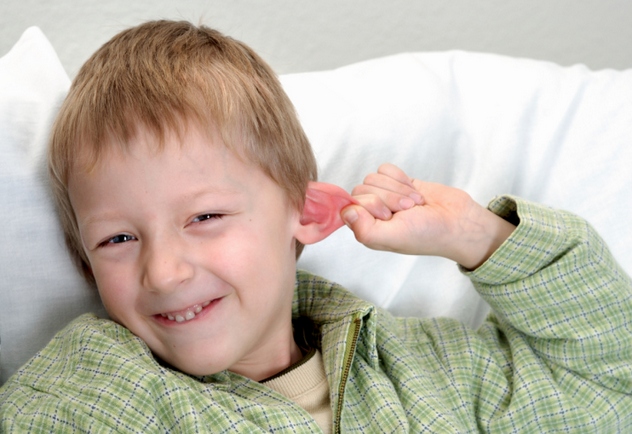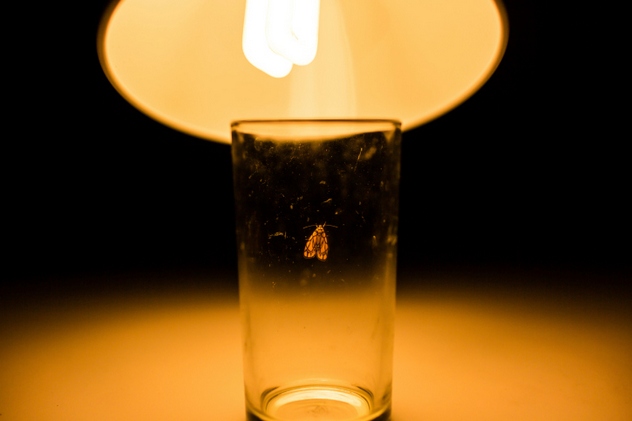 History
History  History
History  Technology
Technology 10 Modern Technologies That Accidentally Imitate Ancient Magic
 Mysteries
Mysteries 10 Mysteries of the Human Genome
 Weird Stuff
Weird Stuff 10 Things So Rare They’ve Only Been Found Once
 History
History 10 Legends Whose Last Moments Undid Their Glory
 Health
Health 10 Futuristic Ideas to Treat Common Medical Problems
 Weird Stuff
Weird Stuff Ten Surreal Attempts to Reverse Baldness
 Facts
Facts 10 U.S. Government Contingency Plans for the Unthinkable
 History
History 10 Weird Distractions from the Great Depression
 Movies and TV
Movies and TV 10 Fictional Kings Who Go from Good to Bad
 History
History 10 Bizarre Friendly Fire Incidents in Military History
 Technology
Technology 10 Modern Technologies That Accidentally Imitate Ancient Magic
 Mysteries
Mysteries 10 Mysteries of the Human Genome
Who's Behind Listverse?

Jamie Frater
Head Editor
Jamie founded Listverse due to an insatiable desire to share fascinating, obscure, and bizarre facts. He has been a guest speaker on numerous national radio and television stations and is a five time published author.
More About Us Weird Stuff
Weird Stuff 10 Things So Rare They’ve Only Been Found Once
 History
History 10 Legends Whose Last Moments Undid Their Glory
 Health
Health 10 Futuristic Ideas to Treat Common Medical Problems
 Weird Stuff
Weird Stuff Ten Surreal Attempts to Reverse Baldness
 Facts
Facts 10 U.S. Government Contingency Plans for the Unthinkable
 History
History 10 Weird Distractions from the Great Depression
 Movies and TV
Movies and TV 10 Fictional Kings Who Go from Good to Bad
10 Details We Don’t Know About Everyday Things
Some days, it seems like there are no mysteries left in our everyday lives. Our diets are dissected to the smallest element, there are countless books on how to raise our children and train our pets, and if we have questions, we can just turn to the Internet to find the answer. However, there are a few things left in our everyday lives that still have the experts stumped.
SEE ALSO:10 Whatchamacallits And Their Real Names
10Why Do Hiccup Cures Work?

Hiccups are weird things, and we’re not even sure why they happen. There’s no real, practical reason for a hiccup, and we don’t know why all of our tried-and-true hiccup cures work. Everyone has their favorites, from eating a spoonful of sugar to holding your breath until the hiccups stop. There are so many ways to get rid of a hiccup that no matter where you are when you get it, someone will have a suggestion for making it stop. It turns out that none of the cures are guaranteed to work for everyone, and there’s not much scientific support for any of them. As for the ones that do work? Well, don’t really know why they do.
Hiccups are essentially caused by the diaphragm having a spasm, which can be caused by anything from laughing to medication. Stopping a hiccup seems to rely on a couple of different things. Raising the amount of carbon dioxide in the blood seems to have some success in stopping hiccups, but no one’s sure what that has to do with the process. Other somewhat successful remedies work by impacting the vagus nerve, which is involved in making sure we don’t try to breathe and swallow at the same time. We don’t know what that has to do with the diaphragm, either, but that seems to be why things like pressing on your eyes or pulling your ear help—those actions stimulate the nerve. Another method that’s been found to cure hiccups is, bizarrely, rectal massage. Used as a cure for an extreme case of the hiccups in 1988, its success was once again traced back to stimulating the same vagus nerve.
9Why Are Moths Attracted To Light?

We’ve all watched it happen, and chances are we never really thought about it that much. Bugs—particularly moths—are attracted to light, but why? It’s the principle that many bug traps and zappers are built on, but no one knows just why it works. There are a couple of different theories about why moths are attracted to light, but there’s not even one that stands out as a front-runner. In fact, there are pretty convincing arguments against all of them.
One theory suggests that only man-made, artificial lights attract bugs. Presumably, there’s something different about artificial light that interferes with the bugs’ ability to navigate, but we don’t even know whether bugs are using light as a navigational aid. It’s also been suggested that moths may be confusing the frequencies of artificial lights with pheromones given off by willing mates, but there’s nothing to really support that theory, either.
Researchers have found that it’s a pretty bizarre behavior, specifically because it seems to cross species but also works against the survival of those species. In spite of the kamikaze behavior that could be expected to discourage the practice—or at least kill off the part of the population that does it—it’s still a major behavior pattern.
8What Is Foam?

Every time you wash dishes or lather your hands with soap, you’re creating one of the most mysterious household compounds: foam. Foam isn’t classified as a liquid, a gas, or a solid, but it’s all three at the same time. Different substances form different types of foam that all seem to work differently. There’s not much that’s actually known about the physics of what forms this weird cohesion of matter states or how we can predict what type of foam will be formed from what type of substance.
Most foams are made up primarily of gas in between bits of liquid, but there’s no mathematical formula for discovering how a foam will behave. Some foams are stiff, like shaving foams, while others are delicate, like soap bubbles. The size of the bubbles doesn’t seem to have any impact on how the foam behaves. The reason we haven’t been able to learn much about foam is a weird one.
Foam bubbles are inherently oddly shaped. The critical point of foam, defined as the moment when all the bubbles in the foam are perfectly spherical, is impossible to achieve on Earth because of gravity. Gravity pulls foam bubbles downward, and its impact is so great that even in a layer of foam just a few centimeters thick, there’s a definite difference between the shape of the bubbles at the bottom and the top. This makes it impossible to perform experiments on foam without changing what it is.
7Why Does Static Electricity Happen?

It’s a mildly annoying occurrence that usually happens when the weather’s dry and you’ve done something like walking across a carpet. While we know how static electricity builds up, the question of why it happens is a surprisingly complicated one, with a weirdly elusive answer.
The problem in finding an explanation happens when one of the materials involved is, theoretically, an electrical insulator. There’s no confirmed reason for why an electrical charge should be transferred from or to an insulating material; an insulator, by nature, shouldn’t allow this. The problem is further complicated by the fact that different materials and conductors have different mechanisms for the cause, buildup, and transfer of static electricity.
A static electric shock can also occur between two objects made of identical materials, which makes the phenomenon even stranger. In theory, the difference in properties should be what makes the electrical charge jump from one material to the other, but experiments performed by rubbing two identical materials together have shown that static electricity still passed between the two objects. Currently, there are no satisfactory answers from the fields of physics or chemistry, suggesting that it’s actually a way more complicated phenomenon than either can account for on their own.
6Where Did Dogs Come From?

They’re some of our most constant companions, but there’s a lot we don’t know about when dogs were first domesticated, where the process happened, and what the first domesticated dogs even were.
Studies on the subject have proven highly inconclusive, with estimates for the first domestication ranging from 9,000–34,000 years ago. Not only is that a huge gap, but it leaves a lot of unanswered questions as to how it happened. Dogs on the most distant end of that scale would have been associating with hunter-gatherer groups, while the more recent instances of domestication would have been happening when the human race had already discovered agriculture and settled into a more sedentary lifestyle.
Researchers from the University of Turku have isolated DNA from some of man’s early canine companions with some staggering implications. Some of the oldest DNA samples were taken from dogs that were living alongside humans around 33,000 years ago and were traced through to dogs that lived in Greenland about 1,000 years ago. But this particular DNA seems to be unrelated to today’s dogs, and it’s now suggested that some of the “dogs” that were domesticated for thousands of years weren’t the same as today’s dogs and were instead a sort of sister species. Ancient dogs have been found in Europe, the Middle East, and Asia, but it’s still not known if the idea of domestication spread from one area to the other or occurred independently in all areas. If it did, it’s not known who was first.
5We’re Not Really Sure What Colors Are

Our world is filled with color, and for the most part, we’ve reached a consensus on what certain colors are. It’s easy enough to identify a banana as yellow and broccoli as green, but what’s to say one person’s image of green is the same as another’s? Not much, and it turns out that science really isn’t sure that we’re all seeing the same colors in the same way. The idea seems odd, especially considering that the mechanism that allows us to see colors is essentially the same: Light enters our eyes, it’s interpreted there, and then it’s processed by our brain. But it turns out that it’s not as clear-cut as that, and the idea of colorblindness is only part of the reason.
We know that different people have different numbers of photo receptors in their eyes. People who are colorblind have weak receptors, most commonly suffering from a deficiency in the ability to detect green (or variations of green). But there’s another end to the spectrum, too: people who are theoretically incredibly sensitive to color. Tetrachromats can see more colors than exist in the normal color spectrum. To them, the rest of us appear colorblind.
But that’s a pretty extreme example, and experiments suggest that the way we see colors can differ considerably between individuals. When monkeys whose photoreceptors would normally only allow them to see blue and yellow were infected with a virus that changed the type of color their eyes could interpret, they demonstrated the ability to see these new colors. They recognized that the colors were different, but we have no way of telling what their brains were interpreting the colors as. They were essentially seeing new colors that their eyes had never had the ability to process, making the link between the eyes receiving colors and the brain processing colors even more vague.
4Is A Virus Alive?

For the most part, everything falls into one of two categories: It’s either alive, or it isn’t. Ever since scientists have been aware of the existence of viruses, they’ve been unable to successfully determine which of these two very distinct groups viruses belong to. Originally, viruses were thought to be alive. The scientists that discovered viruses saw them as organisms that could spread and multiply, suggesting that they were very clearly alive. By the 1930s, however, researchers from the Rockefeller University were finally able to get a look into what was going on inside a virus. Since it didn’t have any metabolic functions, they decided that it wasn’t alive.
But it’s far from clear, as further research by the same team discovered that a virus also exhibits one of the key components of life: reproduction. It not only makes more of itself but creates more proteins and internal chemical structures. Viruses have also been known to change over time, evolve, and carry on processes like repairing damage done to them. All this seems to indicate they’re alive, unless nonliving organisms are also capable of evolution, which seems like a pretty odd thing to even suggest.
Viruses are also unable to carry on these processes outside of a living host, leading some to suggest that they’re functioning on something along the lines of life borrowed from another organism—but that doesn’t make the answer any more clear.
3Why Do We Age (And At Different Rates)?

Every day we deal with the problems of aging, ever so gradually. We’ve been doing it for as long as we’ve been a species, but we have no idea what actually causes it. We know what happens to cells as they age: Muscles lose mass, tissues become more or less rigid, connective tissues stiffen, and new cells become less and less efficient at absorbing nutrients and removing waste. We just don’t know why.
There are a couple of different theories on why cells age the way they do, including the idea that the aging process is a by-product of the body’s waste materials, or that it’s because of damage done by external factors like ultraviolet rays. It’s also been suggested that we’re simply genetically programmed to age, and how fast or how well we age has nothing to do with external factors.
Even more bizarre is the question of why we age at different rates. Looking at the methylation patterns of cells gives an indication of how old they are, and all of our cells age at different rates. Female breast tissue, for example, shows patterns and changes that indicate it’s about three years older than a person’s calendar age. At the other end of the spectrum are heart cells, which age more slowly and can actually test as being several years younger than the body as a whole. Just why the body ages as it does—and why it ages at all—is nowhere near being completely understood.
2What Causes A Migraine?

Those who are prone to migraines know what it feels like to have one starting. It’s a special kind of headache that goes way beyond just pain and can include nausea, vomiting, painful sensitivity to stimuli, blurred vision, and even loss of consciousness. What we’re not sure about is why some people get migraines and why there are so many different triggers for them. Some people can have migraines that are triggered by anything from a change in the weather to bright sunlight and physical exertion. For some, it’s sensory—migraine can be triggered by a certain smell or exposure to a certain food, drink, or food additive.
Even those sensitive to certain triggers don’t always get migraines when they’re exposed to those triggers, and they can also come down with a migraine without being exposed. Just why it happens to people isn’t known, although it’s suspected that there’s a genetic connection, because migraines seems to run in families. One suggestion is that people susceptible to migraines have parts of their brains that are more sensitive to certain stimuli than others or that migraines happen in response to certain changes in brain chemistry. So far, though, there have been no concrete findings regarding just what causes migraines in some people and not others.
1Why Do Allergies Come And Go?

Living with allergies can be a nightmare. From not being able to indulge in ice cream or not being able to own a pet to feeling like you’re always on the verge of coming down with the flu, allergies can make life difficult. Many people suffer from allergies, which makes it even more surprising that we have no idea why they have a tendency to come and go, seemingly at random. Almost any kind of allergy can disappear—and reappear—over time. Some people may find their symptoms are occasionally greatly reduced, even if they don’t go away completely.
Peanut allergies are among the most potentially dangerous types of allergies, and it’s recently been discovered that about 20 percent of people who have peanut allergies as children lose their sensitivity as they get older. As much as 80 percent of children with milk allergies outgrow their sensitivity by the time they’re in their teens, and those allergic to eggs will also commonly outgrow the allergy. Blood tests can tell if an allergy is going away, and sometimes desensitization done with small amounts of food or food prepared in a certain way can help—but this should always be done under the supervision of a doctor. Even stranger is the fact that kids today are much more likely to outgrow their allergies than the kids of the last generation, which raises more questions than it answers.








